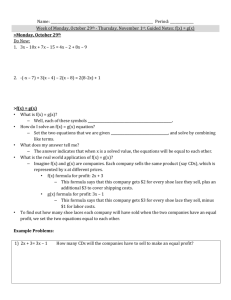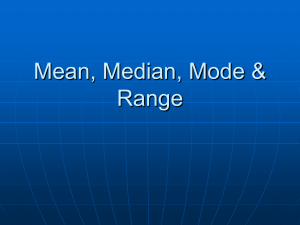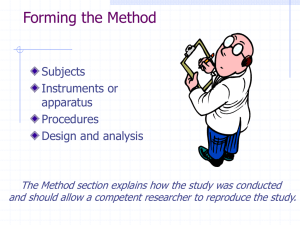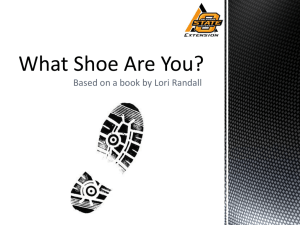Key - CSI
advertisement
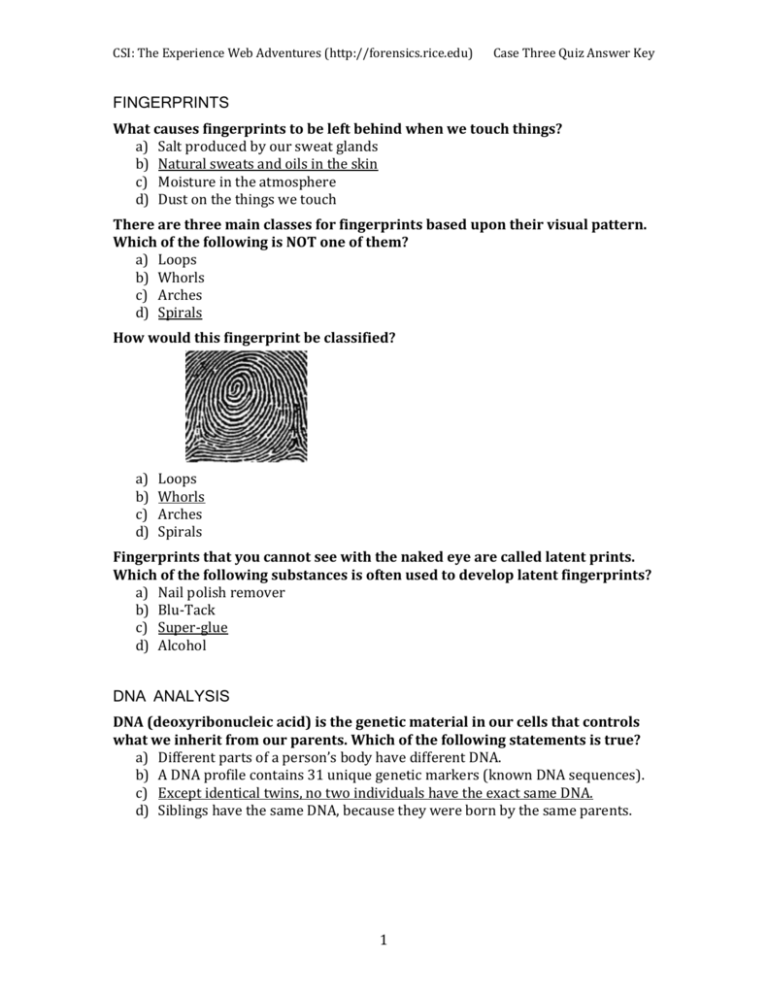
CSI: The Experience Web Adventures (http://forensics.rice.edu) Case Three Quiz Answer Key FINGERPRINTS What causes fingerprints to be left behind when we touch things? a) Salt produced by our sweat glands b) Natural sweats and oils in the skin c) Moisture in the atmosphere d) Dust on the things we touch There are three main classes for fingerprints based upon their visual pattern. Which of the following is NOT one of them? a) Loops b) Whorls c) Arches d) Spirals How would this fingerprint be classified? a) b) c) d) Loops Whorls Arches Spirals Fingerprints that you cannot see with the naked eye are called latent prints. Which of the following substances is often used to develop latent fingerprints? a) Nail polish remover b) Blu-Tack c) Super-glue d) Alcohol DNA ANALYSIS DNA (deoxyribonucleic acid) is the genetic material in our cells that controls what we inherit from our parents. Which of the following statements is true? a) Different parts of a person’s body have different DNA. b) A DNA profile contains 31 unique genetic markers (known DNA sequences). c) Except identical twins, no two individuals have the exact same DNA. d) Siblings have the same DNA, because they were born by the same parents. 1 CSI: The Experience Web Adventures (http://forensics.rice.edu) Case Three Quiz Answer Key What system used by the FBI compiles DNA of known violent offenders from all over the nation and can be used to match DNA with a sample found at a crime scene? a) IAFIS b) DNAW c) CODIS d) CDDB A woman gets out of bed, watches TV, talks on the phone, pets her cat, and then goes shopping. Which object would be most useful in collecting the woman’s DNA sample? a) The TV b) The cat c) The phone d) The TV remote Decide the correctness of the following statement: You can alter your DNA so it will appear to be different. a) True b) False Which part in the cell below contains most of the DNA? a) b) c) d) e) f) A B C D E F If we compare a boy’s DNA with his parent, what result will we find out? a) The child has 50 DNA markers that are the same as his mother. b) The child has 50 DNA markers that are identical to his father. c) 50% of the child’s markers are identical to his mother. d) All of the boy’s DNA markers are identical to his father. 2 CSI: The Experience Web Adventures (http://forensics.rice.edu) Case Three Quiz Answer Key Are these two DNA profiles a match? a) Yes b) No SHOEPRINTS A plastic shoe print occurs when a shoe sinks into a soft substance like mud. How would an investigator collect a plastic shoe print from the crime scene? a) Use electrostatic treatment to lift the shoe print b) Use dyes to bring up the impressions c) Dust the shoe print with special powders d) Use dental plaster to make a cast of the shoe print Below are steps involved in making a cast of a shoe print. What is the correct order in this process? A. Remove the casted mold from the shoe prints B. Mix dental plaster with water C. Apply hairspray to the site D. Pour the dental plaster mix next to the shoe prints a) BDAC b) CBDA c) BCAD d) DBCA Class characteristics of a shoe print are marks that are a direct result of the manufacturing process of the shoes. Which of the following is not one of the class characteristics? a) Shoe size b) Manufacturer c) Shoe types d) Random cut on the shoe’s sole When doing shoe print comparison, investigators have to identify ________________ in order to decide if the shoe prints are a match. a) the origin of the shoe b) the material of the shoe c) the unique markings of the shoe d) the specific color of the shoe 3 CSI: The Experience Web Adventures (http://forensics.rice.edu) Case Three Quiz Answer Key FACIAL RECONSTRUCTION In facial reconstruction, which is one of the crucial factors when considering the tissue depth? a) Gender b) Weight c) Height d) Surrounding environment Which statement is true about facial reconstruction? a) A skillful artist is the only key to the success of facial reconstruction. b) Tissue depth markers are put on the skull after the sculpture is completed. c) A reconstructed face is usually the same as what the person looked like. d) Teamwork of artists and forensic scientists on reconstruction projects increases the success rate for identification. TOOLMARKS Which lab equipment is usually used to analyze toolmark evidence? a) Light table b) PCR machine c) Comparison microscope d) Super-glue fuming chamber How do investigators know a suspected knife is the weapon that was used to kill the victim? a) They put the knife directly on the wound of the victim and see if there is a match. b) They photograph the wound and see if the knife matches the shape of the wound. c) They take impressions from the wound and the knife toolmark and see if there is a match. d) They analyze the fingerprints on the knife and see if they match the victim. DIGITAL FORENSICS What is the first step in analyzing digital evidence from a computer? a) Use antivirus programs to prevent computer virus. b) Use imaging tools to create an exact duplicate of the hard drive. c) Examine deleted files to find out what the suspect is trying to hide. d) Find out the latest activities on the computer and look into relevant information. 4 CSI: The Experience Web Adventures (http://forensics.rice.edu) Case Three Quiz Answer Key Which of the following is what investigators would do when they examine a computer? a) Print out every useful information on the computer. b) Skip images and audio files because these are mainly for fun. c) Install programs to monitor suspicious online activities. d) Discover and crack passwords to gain access to information. OTHERS Which of the following is considered part of the medical examiner’s job? a) Determining if the victim was murdered b) Analyzing victim’s DNA sample c) Doing facial reconstruction to identify the victim d) Documenting wounds on the body A corpse is discovered buried in a field. It may be Jenny who was reported missing a few years ago and is now feared dead. The body is decomposed and is not easily identifiable. How might the investigator decide whether the body is Jenny? a) Use facial reconstruction technique and compare the reconstructed photo with Jenny’s picture Match Jenny’s dental records with the teeth and jaw of the body Analyze the skeletal remains to decide the gender of the body b) Compare the fingerprints from the deceased with those from Jenny’s mother 5
